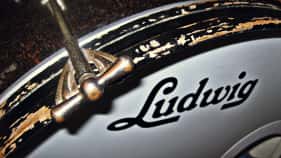
Bass Drum Tuning
Bass Drum Tuning – Tune It or Stuff a Bunch of Crap in It?
 So often the kick drum gets overlooked when it comes to tuning. The heads usually aren’t replaced as often as they are for other drums. In the pursuit of a really low sound, I would wager that most people tune the kick drum heads as low as they can get away with and then stuff the drum full of fluffy stuff and hope for the best. And, depending on the drum, that may be exactly what to do to get a great sound. But wouldn’t you like your kick sound to be the result of your know-how and artistic decision and less the result of chance? That’s what this entry on bass drum tuning is all about.
So often the kick drum gets overlooked when it comes to tuning. The heads usually aren’t replaced as often as they are for other drums. In the pursuit of a really low sound, I would wager that most people tune the kick drum heads as low as they can get away with and then stuff the drum full of fluffy stuff and hope for the best. And, depending on the drum, that may be exactly what to do to get a great sound. But wouldn’t you like your kick sound to be the result of your know-how and artistic decision and less the result of chance? That’s what this entry on bass drum tuning is all about.
Batter/Resonant Relationships – Kick Edition
Two entries ago (the entry about generalized drum tuning), I wrote about the relationship between the batter (top) and resonant (bottom) drumheads. Everything there holds true with bass drum tuning too. However, I do approach the kick a little differently. Here’s why:
- We are dealing with pitches in the sub-sonic range (fundamentals between 40-80 Hz) and head “pitch” can be difficult to determine.
- The previously mentioned relationships deal with sustain. Sustain in a kick drum is generally something drummers and producers want to avoid in modern music.
- I tend to tune my batter head slightly above wrinkling (on a 20” or 22” diameter drum). That creates a fairly low fundamental pitch and, by comparison, the single ply resonant heads I use tend always to sound higher in pitch.
- The batter heads I use for kicks usually have some slight muffling involved from the get go (like the Evans EMAD system or the Aquarian Super Kick series) which, again, make “pitch” difficult to determine.
While I have tried all sorts of tuning relationships, for most modern music I get the best results when I tune in the following manner:
- I tune the batter head so that the wrinkles just disappear (this is usually a point when the tension rods just start to keep the rim clamps from rattling freely). I then tune up each lug 1/4 to 1/2 turn all around the head. I try my best to focus on an overtone as I tap a stick near each lug and try to match. If I’ve done it right, slight wrinkles appear around the edge of the head when I press firmly with my palm in the middle of the head.
- I tune the resonant head to the loosest possible tuning (where visible wrinkles just disappear and the bass drum rim clamps just start taking hold). I then tune each lug up 1 full turn. At this point, the resonant head (if it is single ply) has at least some apparent overtones that should allow you to match the tuning of the lugs across the head.
For an example, I used my Ludwig Classic 16X22” maple kick drum fitted with an Aquarian Super Kick II batter head and a ported single ply resonant head. Here’s what the sound is like when I’m done tuning but before adding muffing.
I should note here that the tuning technique I use works great for 20” and 22” diameter drums. Bigger diameter drums might have to be tuned a little higher. More on this later.
Kick Muffling
Most kick drums (unless your doing jazz combo work or going for a non-standard sound) are muffled in some way to reduce the sustain and overtones the drum could produce. Suggestions of what to stuff in your kick drum abound from specifically branded products to old towels and blankets. I have used most of these methods. Currently, in my main rock/pop kick drum, I use at least one towel and sometimes add to that an Evans EQ Pad.
You get different sounds by muffing different parts of the drum. Let’s take our kick drum from before and muffle it. In this first example, you’ll hear a single towel touching only the batter head on the inside of the drum. The resonant head is left untouched. To me, this sounds horrible. You get all of the ring of the resonant head and the batter muffling reduces some of the cutting “smack” of the beater.
Now, here’s what it sounds like to muffle just the resonant head and leave the batter head untouched. This is my favorite sound for rock sessions. There is a very bright attack to the drum from the beater and the resonant head overtones are well under control.
And finally, let’s hear what it sounds like when the towel touches both drumheads. The sound is similar to the last example except there is a little less “smack” from the beater. This is a good option if you use plastic beaters (in the examples I use a round felt beater) or if you want a less cutting kick sound.
About Beaters and Kevlar Patches
The beater you use is a matter of preference. I usually use the stock DW felt beater that comes with their pedals. I sometimes use a round entirely felt beater (as I did in these examples). Rarely do I use a plastic or other type of hard beater in the studio. Regardless of what kind of beater you use, it seems you can get the most tone out of your kick drum if the beater hits dead center in the head (or even slightly above the center). That’s important to remember when dealing with smaller 18” and 20” kick drums.
As for kevlar patches or “Falam” pads, I personally cannot stand the things. I feel they add a plastic “slappy” sound to a kick drum. However, I know tons of people that use them. A lot of guys use them simply to extend the lives of their bass drum batter heads and not for any tonal help. So, the choice is up to you.
How to Make Big Kicks Sound Big
As a producer and mixer, I have worked with several bands whose drummers have large diameter kick drums (24” and up). The desire seems to be for a powerful bottom end with plenty of sub. The only thing is, some players tune the drums as low as possible to achieve this. That can be problematic because you might actually be tuning the fundamental frequency of the drum below the frequency threshold of human hearing (in pristine conditions, the ideal human ear would hear down to 20Hz). In this case, when the drum is hit, all you hear are overtones and harmonics of the fundamental. Instead of sounding powerful and meaty, the kick (especially to a microphone or two) sounds anemic and “slappy.” It’s counter intuitive, but sometimes a big bass drum has to be tuned more tightly than one might think in order to achieve a bigger, fuller sound. So, if your 18×24” kick sounds weak, tune it higher and you may be surprised!
Additional Bass Drum Tuning Tips
- Some heads like the Evans EMAD and the Aquarian Super Kick series have small muffing devices attached to the outer perimeter of the head. This does some muffling for you.
- A way to muffle a kick drum that was popular in the past was to take a strip of felt, stretch it across the shell cheating one side (with the head off) and tightening the drumhead on top to hold the felt in place. This works well with really big drums like a 26”.
- If your kick doesn’t have enough focus or too many overtones, try taking the resonant (front) head off completely. Some studio guys do this anyway to get mics inside more easily.
- Engineers will love you if you think to have your front head ported at about the 3:30 or 4:00 position. While it is common to port a head around the 5:00 position, it can sometimes prove problematic to get a mic inside since the position is not as accommodating to mics on traditional boom stands.
If you haven’t already, check out my other two entries on general drum/tom tuning and snare tuning.


